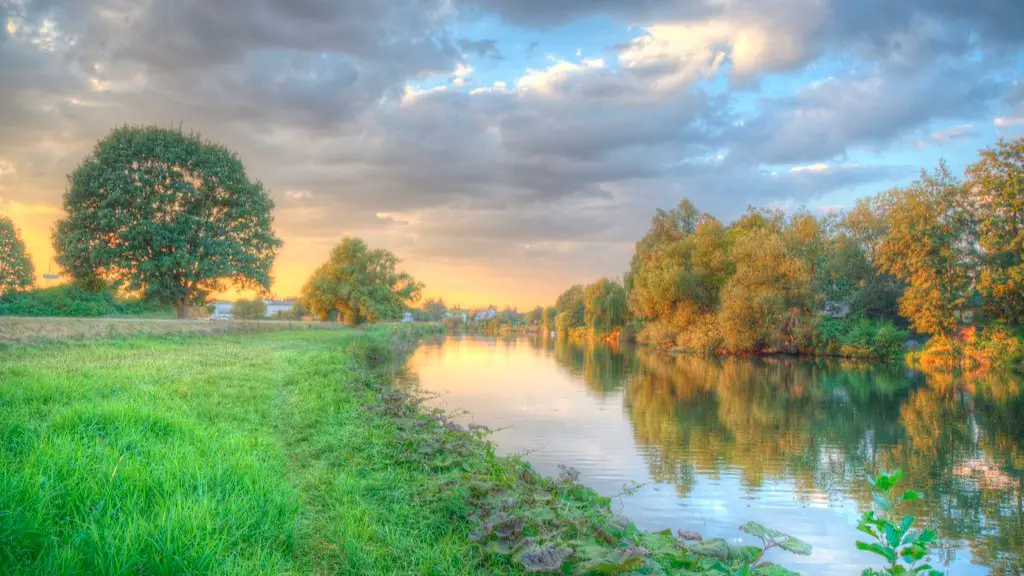The Mississippi River has been an integral part of the history of American exploration as well as its economy. Spanning an impressive two thousand and four hundred miles, the river has served as the gateway to the American West, allowing merchant ships and other vessels to access the port city of New Orleans. One of the most popular ports of call along the river is the Erato Street Cruise Terminal, located just south of downtown New Orleans. Although the exact depth of the Mississippi River can vary depending on the time of year, the water at the Erato Street Cruise Terminal typically ranges between 40-54 feet.
The depth of the river is influenced by several factors, including the snowpack and rainfall in the upper and lower parts of the river. When levels of snowmelt and rainwater are higher than normal, the river swells and increases its volume, making it much deeper. Conversely, when there is a lower-than-normal amount of snowmelt and rainwater, the river will naturally shrink and become shallower. The US Army Corps of Engineers also plays a major role in controlling the depth of the Mississippi River. In an effort to keep the river navigable for larger ships, the Corps regularly dredges the river’s bottom, removing any excess sediment and ensuring that the river remains at a usable depth.
The cruise terminals at the Erato Street port are designed to handle larger vessels and ships, which require a much deeper depth to navigate safely. Without the regular dredging efforts of the US Army Corps, the river would become too shallow to accommodate these ships, resulting in a serious disruption of regional shipping and commerce. The ports also benefit from the sheer size of the Mississippi River, as even with its smaller depth, the river’s large volume of water still allows for large ships and vessels to pass through without issue.
The Mississippi River is an essential part of the region’s economy, and its depth near the Erato Street Cruise Terminal plays an important role in allowing commerce to thrive. Thanks to the ongoing efforts of the US Army Corps, the river is able to maintain a rate of about 40-54 feet deep near the cruise terminal. This depth is essential to maintaining the safety of navigation and avoiding any disruption to the regional economy.
The Ecological Impact of the Mississippi River
Aside from its importance as a traderoute, the Mississippi River is also host to numerous species of fish and other aquatic life. The freshwater that flows through the Delta region of the river creates an ideal environment for several species of fish, and largemouth bass, bluegill, crappie, catfish, carp, and many other species are commonly found in its waters. To maintain these fish populations and the other species found within the environment, it’s important for the river to have an adequate level of water for the fish to thrive. To accomplish this, the US Army Corps closely monitors the water level of the Mississippi River.
When the river becomes too shallow due to lack of rainfall, the Corps must take steps to protect wildlife by releasing water from the upstream reservoirs into the river. Although this lowers the reservoirs’ levels, it allows the river to maintain enough depth for the fish and other aquatic life to survive. The increased depth is also beneficial to those who use the river for recreation, as it ensures that there is enough water available to support recreational activities such as fishing, boating, and swimming.
The Corps also restricts activities such as dredging and underwater excavation to certain areas of the Mississippi River. By limiting these activities to certain areas, the Corps can help to protect the river’s delicate ecosystem and ensure that the river remains deep enough to support the species that depend on it for survival. The Corps’ regulations also ensure that activities such as dock construction and vessel passage will not disrupt the water flow.
The Human Impact of the Mississippi River
The impact of the Mississippi River is not limited to just the environment, however. The river also plays an important role in the region’s economy. As one of the largest rivers in the United States, the Mississippi supports major cities like New Orleans and Baton Rouge, providing them with access to international markets. Its vastness and deep waters also make it ideal for large vessels, allowing companies to transport goods quickly and safely.
The river is also lined with several plantation homes, providing an important part of America’s history and culture. These homes are open to visitors who want to take a step back in time and experience the beauty, charm, and grandeur of the Mississippi River region first-hand. The river also provides many residents of the region with access to a variety of recreational activities, including fishing, swimming, and boating.
The depth of the Mississippi River near the Erato Street Cruise Terminal is an essential factor in ensuring the safety of navigation, the preservation of the river’s unique environment, and the economic prosperity of the region. By maintaining an adequate level of water, the US Army Corps can ensure that the river remains navigable for vessels of all sizes, while also helping to protect the delicate ecosystems that make the Mississippi River so vital to the region.
Cruise Terminal Expansion and Development
The Erato Street Cruise Terminal has seen increased levels of activity in recent years. In order to alleviate overcrowding and accommodate the increased volume of travelers and vessels, the terminal has been undergoing significant expansion and renovation. This expansion includes the construction of two additional piers, as well as the expansion of existing infrastructure. In order to complete these renovations safely and effectively, the US Army Corps has been tasked with ensuring that the river maintains a minimum depth of 40 feet.
The expansion of the Erato Street Cruise Terminal is just one example of how important the depth of the Mississippi River is to the region. By allowing larger vessels to access the port safely, the Corps can help to support both the local economy and the recreational activities of those living in the vicinity. The Corps’ ongoing efforts to ensure the river remains deep enough to serve its purpose have been essential in maintaining the river’s vital role in the region.
Comparison With Other Mississippi River Ports
The depth of the Mississippi River near the Erato Street Cruise Terminal is not atypical for a port on the river. In fact, many other ports on the Mississippi are comparable in terms of depth. For example, most of the ports in the Delta region of the river typically have depths of no more than 54 feet. In Lake Providence, the water ranges between 20-40 feet. Even in Baton Rouge and Natchez, the water is typically no deeper than 50 feet.
These depths are all comparable to the depths seen at the Erato Street Cruise Terminal. This is no coincidence, as the ports throughout the river have been regulated by the US Army Corps for decades. In order to ensure safety for vessels, the Corps has set a standard for maximum depth at each port of call. As the river fluctuates over time, the Corps must take steps to ensure the water remains deep enough to accommodate ships of all sizes.
The Benefits of a Full Mississippi River
The full depth of the Mississippi River at the Erato Street Cruise Terminal proves beneficial for all involved. By keeping the river at an adequate level, the US Army Corps can provide safe passage for vessels and ships, while also protecting the delicate ecosystems of the river. In addition, a full river allows for better navigation and easier transport of goods, which helps to boost the regional economy. The full depth also allows recreational activities to take place, allowing locals and visitors alike to enjoy the beauty of the Mississippi River.
The exact depth of the Mississippi River near the Erato Street Cruise Terminal will fluctuate from year to year. However, the full depth provides numerous benefits for the region as a whole. By keeping the river navigable for vessels of all sizes, the US Army Corps can ensure that waterways remain open for commerce and recreation. Ultimately, the role of the Corps in keeping the Mississippi River at its full depth cannot be understated.
Conclusion of the Importance of MS River Deepness
The importance of the Mississippi River’s depth for commercial and recreational purposes cannot be overstated. Thanks to the efforts of the US Army Corps, the river is able to maintain a depth of around 40-54 feet near the Erato Street Cruise Terminal. By doing so, the Corps is able to help support regional commerce by allowing larger vessels to safely navigate the waters. In addition, the full depth helps the region’s ecosystem by providing a natural habitat for fish and other aquatic life. And, of course, it allows residents and visitors to participate in a variety of recreational activities along the Mississippi River.




